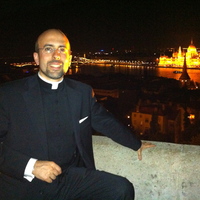Papers by Elena Cerqua

Annali di Storia dell'Esegesi 40/2, 2023
Conflict and violence are at the core of Miguel de Unamuno’s philosophical and political thought.... more Conflict and violence are at the core of Miguel de Unamuno’s philosophical and political thought. A never-ending dialectic is the method of his reasoning according to his conception of life as a continuous fight of opposites, preferred to the deathly stillness of any synthesis. Considering this theoretical frame, the present paper argues that the unamunian antagonistic relationship among fellow citizens is shaped on a Biblical paradigm, as he touches on the Abel and Cain myth and on the foundation of the City of Enoch (Gen 4:1–18). According to Unamuno, indeed, in violence resides the origin of civilization and its prosecution in the State, composed of loving “brothers” fighting a metaphorical civil war. In this regard, the paper theorizes the influence of the First Johannine Epistle and proposes that Unamuno’s hateless reinterpretation of fratricide is combined with the Heraclitean conception of global harmony as πόλεμος, which prevents the end of collision by rendering it perpetual and reciprocal.
Erasmo libero. Le litterae e la teologia, a cura di Lorenzo Geri e Gaetano Lettieri, Roma, Viella, 2023
C o pyrig ht © Viella N.B: C o pia a d uso p ersonale e istituzionale. È vietata la ripro d uzion... more C o pyrig ht © Viella N.B: C o pia a d uso p ersonale e istituzionale. È vietata la ripro d uzion e (totale o p arziale) d ell'o p era con q ualsiasi m ezzo effettuata e la sua m essa a disp osizion e di terzi, sia in forma gratuita sia a p a g am e nto. Erasmo libero Le litterae e la teologia a cura di Lorenzo Geri e Gaetano Lettieri viella C o pyrig ht © Viella N.B: C o pia a d uso p ersonale e istituzionale. È vietata la ripro d uzion e (totale o p arziale) d ell'o p era con q ualsiasi m ezzo effettuata e la sua m essa a disp osizion e di terzi, sia in forma gratuita sia a p a g am e nto.

De Medio Aevo 12/2; The Pope, New Moses. From Eugene IV to the Medicean Popes, 2023
In the oration Moyses, vir Dei (1452), the Italian humanist Aeneas Silvius Piccolomini addresses ... more In the oration Moyses, vir Dei (1452), the Italian humanist Aeneas Silvius Piccolomini addresses the pope, Nicholas V, the request for a crusade against the Turks. In addition to exposing the necessity and feasibility of a crusade, Piccolomini addresses the issue of papal authority. Indeed, on the one hand, the oration admits the superiority of pontifical power over imperial or conciliar power; on the other hand, it identifies the pope as the only person having the authority to decide on crusade matters. In both cases, Piccolomini resorts to identifying the pope with Moses, inheriting two Medieval and Renaissance traditions. According to the first one, Mosaic authority is the model for papal authority. Received directly from God, it is therefore indisputable, insurmountable and indivisible. According to the second tradition, Moses is the typological prefiguration of Christ and of the crusade leader, intent on leading the Chosen People towards earthly and eternal freedom. The present study aims to analyze the interplay, in the oration, of these two typological frames.

Studi e Materiali di Storia delle Religioni 87/2, 2021
Il presente contributo prende in esame il racconto di Miguel de Unamuno "San Manuel Bueno, márti... more Il presente contributo prende in esame il racconto di Miguel de Unamuno "San Manuel Bueno, mártir", e si sofferma, in particolare, sul significato della confessione e del pianto del protagonista, Manuel, qui descritto come un nuovo Cristo privo di fede. Nella confessione e nel pianto, infatti, Manuel racconta la propria intimità ad Angela, madre spirituale, che a sua volta la tramanda sotto forma di memoria. Venuta meno la speranza nella vita eterna, Manuel esperisce il narrarsi in confessione come un modo di perpetuarsi nella storia, nel ricordo che al prossimo giunge di noi. Attraverso l’analisi del tema della maternità spirituale, si è tentato di mostrare come ad incoraggiare la narrazione di sé all’altro in questa novella sia l’attitudine amorevole e mai giudicante della “madre” – il cui paradigma è, per Unamuno, la figura piangente e urlante della Mater Dolorosa. Seguendo Unamuno, si è dunque intesa la possibilità del farsi storia come “femminile” e si è mostrato come ad ispirare l’operare altruistico di Manuel siano l’amore e la capacità di perdono della “madre”. Da tale prospettiva, si è giunti ad ipotizzare che Manuel possa rappresentare la figura di un Cristo dai tratti materni.
This article investigates Miguel de Unamuno’s novel "San Manuel Bueno, mártir". In particular, it focuses on the meaning of confession and weep of the novel’s main character, Manuel, who is described as a new faithless Christ. In confession and tears, indeed, Manuel narrates his intimacy to Angela, a spiritual mother, who hands it down in the form of written memory. Lost any hope in eternal life, Manuel experiences how self-narration in confession becomes the very possibility of self-perpetuation in history, in the neighbour’s memory. Through the analysis of spiritual motherhood, this article aims to show how, in Unamuno’s novel, the self-narration in front of the other is encouraged by the loving and non-judgmental attitude of the “mother”, whose paradigm, in Unamuno’s imagery, is the weeping and screaming figure of Mater Dolorosa. Following Unamuno, the possibility of self-historicization of the individual has therefore been intended as “feminine”, and Manuel’s altruistic behaviour as inspired by the love and forgiveness of the “mother”. From such a perspective, this article hypothesizes that the character of Manuel might represent the figure of a Christ with maternal features.
Conferences, Lectures, and Workshops by Elena Cerqua
Progetto realizzato con il contributo dell'Otto per mille valdese.
L'apocrifo nel canonico FRANCESCO BERNO Sapienza Università di Roma «Gesù non aveva parlato ai di... more L'apocrifo nel canonico FRANCESCO BERNO Sapienza Università di Roma «Gesù non aveva parlato ai discepoli riguardo…»: l'apocrifo eterno ed il Nuovissimo Testamento gnostico ANDREA ANNESE Università di Bologna "Scritti apocrifi": una categoria ossimorica? Alcune riflessioni a partire da Platone, Clemente di Alessandria e i testi gnostici PAUSA: 11.30-12.00 ALBERTO CAMPLANI Sapienza Università di Roma Apocrifi ai confini tra le fedi. Gli Atti di Tommaso e l'Inno della perla tra lettura manichea e recupero cattolico ALBERTO D'ANNA Università degli studi Roma Tre No boundaries. Il campo degli apocrifi e i suoi mutevoli confini
Call for Papers by Elena Cerqua

Mystical Borders. Reshaping Western Mysticism from Antiquity to the Contemporary World The study ... more Mystical Borders. Reshaping Western Mysticism from Antiquity to the Contemporary World The study of mysticism in its broadness questions the epistemological and methodological framework of the historiographical enquiry. As stated by Michel De Certeau (1925-1986), the mystical phenomenon is far from being a stable historical object. On the contrary, the mystical experience conceals an absent void at its core, an emptiness structuring the relationship between a paradoxical scientifical object and multidisciplinary research. This posture leads to redefining the concept of "scientificity" in itself, thus imposing the need to consider the "paradigm shifts". This panel aims to focus on the roots and development of western mystical traditions from a diachronic point of view, from antiquity to modern and contemporary world. Among the shifting paradigms, the first to be discussed concerns the opposition between orthodoxy and heterodoxy, that is between institutional powers and elusive forms of heretical resistance. Hence, all traditional partitions can be rethought, and objections rebalanced. As a consequence, humanities must adopt a new posture with respect to the study of mysticism. History of religions, literature, philosophy, history of art and demoethno-anthropological studies: these and other disciplines are involved in the reflection on the history of mysticism. Indeed, the very marginality of the latter allows the deconstruction of any boundary.










Uploads
Papers by Elena Cerqua
This article investigates Miguel de Unamuno’s novel "San Manuel Bueno, mártir". In particular, it focuses on the meaning of confession and weep of the novel’s main character, Manuel, who is described as a new faithless Christ. In confession and tears, indeed, Manuel narrates his intimacy to Angela, a spiritual mother, who hands it down in the form of written memory. Lost any hope in eternal life, Manuel experiences how self-narration in confession becomes the very possibility of self-perpetuation in history, in the neighbour’s memory. Through the analysis of spiritual motherhood, this article aims to show how, in Unamuno’s novel, the self-narration in front of the other is encouraged by the loving and non-judgmental attitude of the “mother”, whose paradigm, in Unamuno’s imagery, is the weeping and screaming figure of Mater Dolorosa. Following Unamuno, the possibility of self-historicization of the individual has therefore been intended as “feminine”, and Manuel’s altruistic behaviour as inspired by the love and forgiveness of the “mother”. From such a perspective, this article hypothesizes that the character of Manuel might represent the figure of a Christ with maternal features.
Conferences, Lectures, and Workshops by Elena Cerqua
Call for Papers by Elena Cerqua
This article investigates Miguel de Unamuno’s novel "San Manuel Bueno, mártir". In particular, it focuses on the meaning of confession and weep of the novel’s main character, Manuel, who is described as a new faithless Christ. In confession and tears, indeed, Manuel narrates his intimacy to Angela, a spiritual mother, who hands it down in the form of written memory. Lost any hope in eternal life, Manuel experiences how self-narration in confession becomes the very possibility of self-perpetuation in history, in the neighbour’s memory. Through the analysis of spiritual motherhood, this article aims to show how, in Unamuno’s novel, the self-narration in front of the other is encouraged by the loving and non-judgmental attitude of the “mother”, whose paradigm, in Unamuno’s imagery, is the weeping and screaming figure of Mater Dolorosa. Following Unamuno, the possibility of self-historicization of the individual has therefore been intended as “feminine”, and Manuel’s altruistic behaviour as inspired by the love and forgiveness of the “mother”. From such a perspective, this article hypothesizes that the character of Manuel might represent the figure of a Christ with maternal features.